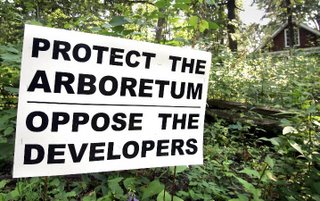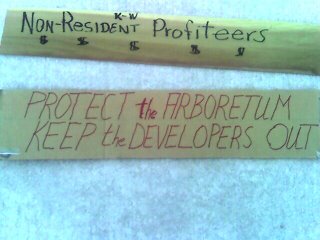 This is a great press release found over the weekend. Truly sheds light on what's really happening in the U.S.
This is a great press release found over the weekend. Truly sheds light on what's really happening in the U.S. NIMBY (Not In My Backyard) vs. BANANA (Build Absolutely Nothing Anywhere Near Anybody)
November 2006
U.S. ATTITUDES AGAINST LAND-USE DEVELOPMENT GROW DEEPER AND WIDESPREAD, SURVEY REVEALS
Negative mind-set dominates results of second national Saint Index© across 14 industries and five regions; citizens turn thumbs-down on effectiveness of local officials in land-use issues.
Toplines and trends from The Saint Index© sponsored by The Saint Consulting Group:
Opposition to development still remains strong: 1 in 5 Americans actively oppose it.
70% of Americans would use taxes to keep land un-developed.
Even greater opposition surfaces about landfills, power plants, and quarries.
Not such bad news this year for casinos, though still not welcome in most American communities.
Opposition to Wal-Mart is more prevalent, though less intense.
75% of US residents give their local elected officials a C or worse, when it comes to deciding what does and does not get built in their communities.
Development has become a decisive political issue in local and regional elections.
Significant support turns up for new hospitals, even as opposition grows.
There is a unquestionable Kelo backlash: 71% support laws stopping eminent domain for private development.
For the second consecutive year, The Saint Index©, a survey commissioned by The Saint Consulting Group - considered the US's foremost analyst in land-use politics finds that Americans are strongly opposed to real estate development projects. In fact, twice as many continue to actively oppose development as support it.
Further, 70% of Americans support using tax dollars to keep land undeveloped, and 38% feel that "strongly." And, according to the just-completed survey, Americans are less concerned about the environment [11% response] than they are about protection of property values [36%] and preservation of community character [29%].
Saint Consulting initiated the Saint Index to assess attitudes and activism towards real estate development. "The survey has begun to yield trends," says Patrick Fox, the international company's Boston-based president. The telephone research occurred in September and early October, interviewing 1,000 respondents randomly selected across the States.
"Americans are looking for ways to stop development," Fox reports. In fact, nearly three-quarters of Americans do not want any new development in their own communities - although the very projects they oppose [landfills, quarries, power plants, and Wal-Mart, for instance] would probably be all right someplace else.
Some development sectors in the 2006 survey have encountered LESS opposition this year - that is, opposition continues but to a lesser extent than in 2005:
Apartments/condominiums - 34% opposed [down from 48% last year]
Casinos - 67% opposed [down from 80%]
Grocery stores - 25% opposed [down from 33%]
Office buildings - 40% opposed [down from 47%]
Large shopping centers - 57% opposed [down from 62%]
Single-family housing - 6% opposed [down from 13%]
Some sections remain as equally opposed this year as last, tending to more opposition:
Home improvement centers - 56% in 2006, 55% in 2005
Department stores - 55% in 2006, 53% in 2005
However, some sectors face EVEN MORE opposition than in the 2005 Saint Index:
Biotech research - 57% opposed [up from 48% last year]
Landfills - 87% opposed [up from 82% last year]
Power plants - 75% opposed [up from 66%]
Quarries - 76% opposed [up from 63%]
Wal-Mart - 68% opposed [up from 63%]. In point of fact, 61% of those polled say they like the big-box experience, but not in their own community.
How to overcome opposition "Land-use politics is one way to block - or support - a building project," says Fox. "Developers, utilities, institutions, among many other sectors facing mounting opposition and permitting delays, need to face the political demands of the public approvals process, start outreach early, and mount aggressive campaigns to educate and organize the communities in which they propose to operate.
This is essential for overcoming anti-competitive opposition and winning local approvals."
Development has become a clear political issue. Poll respondents indicate that a political candidate's position on growth and land-use matters a great deal to them. According to the 2006 Saint Index:
93% of Americans say that a candidate's position on new development and growth is important when they decide for whom to vote. [This forceful statistic corroborates last year's Saint Index, which yielded the same number.]
75% of US residents give their local elected officials a C or worse, when it comes to deciding what does and does not get built in their communities. [Last year, 61% indicated that local government does a fair-to-poor job on planning and zoning issues; this year, it's 66%.]
Cynicism over the system is growing, with 75% of Americans saying that the relationship between elected officials and developers makes the permitting process unfair. [This is up from 70% last year.]
71% support state laws that halt the use of eminent domain for private development. [In 2005, when the Supreme Court's Kelo decision - that local governments may seize private property for economic development purposes - was passed down, the first Saint Index learned that 81% of Americans opposed allowing the taking of private property by eminent domain.]
Americans support hospitals - Competition, unions don't
The 2006 Saint Index finds significant public support for new hospitals. Yet at the same time, hospitals in many areas of the country - non-profit and for-profit alike - face strong opposition when submitting plans for a new facility or expansion.
"It's counter-intuitive to think that hospitals wouldn't have smooth sailing through approvals," Fox says, "when support for healthcare facilities expansion reflects a number of social and business issues working in tandem, from the aging of baby boomers to major technological advances that require the services of flexible, more modern facilities."
"However," Fox comments, "considerable, effective opposition persists. In fact, there's a story behind many of the stories about hospital expansion that has been stalled - and it's not the result of the typical NIMBY [not-in-my-backyard] factor," he comments.
Investigation into attitudes towards hospital expansion - a new category in The Saint Index - shows that:
71% of Americans would support a new hospital in their community. "This is the second most supported land-use we tested [single-family housing was supported by 84%]," Fox notes.
90% of respondents supported an increase in emergency room [ER] capacity at their local hospital [53.4% strongly supported that capacity].
Over three-quarters of respondents [78%] prefer to be within 10 miles of a hospital [44.2% within 5 miles]. Almost three of four respondents [74%] support non-profit hospitals over for-profit institutions.
Fox points out that "Anticompetitive opposition is coming from other local hospitals, which may view the new facility as competition. It also comes from organized labor, which is known for its ability to influence decision makers and effect change through political pressure. In short, this opposition is not grassroots-generated. We are seeing this throughout the US."
Background on Saint Consulting and 2006 Saint Index©
The Saint Consulting Group began operations in 1983 and today is the global leader in land-use political consultancy. Saint Consulting has 12 offices around the US [including its headquarters near Boston], one in the UK, and a Toronto office scheduled for early 2007. Signs of Saint Consulting's success are: a staff of 75, annual fees closing in on $30 million in FY 06, 47% growth in the last year, and a success rate of over 90%. Among the industries that use its services are aggregates, casinos, grocery and retail, healthcare, landfills, mixed-use developments, housing, and utilities.
2006 Saint Index© research quantifies and tracks the politics of land use, spotlighting who actively opposes and supports real estate-related projects and why. It was first conducted in the US in autumn of 2005; this is its second round. The Saint Index/UK survey occurred in April 2006.
# # #
© Copyright 2006, The Saint Consulting Group, Inc.
Background on Saint Consulting and 2006 Saint Index©
The Saint Consulting Group began operations in 1983 and today is the global leader in land-use political consultancy. Saint Consulting has 12 offices around the US [including its headquarters near Boston], one in the UK, and a Toronto office scheduled for early 2007. Signs of Saint Consulting's success are: a staff of 75, annual fees closing in on $30 million in FY 06, 47% growth in the last year, and a success rate of over 90%. Among the industries that use its services are aggregates, casinos, grocery and retail, healthcare, landfills, mixed-use developments, housing, and utilities.
2006 Saint Index© research quantifies and tracks the politics of land use, spotlighting who actively opposes and supports real estate-related projects and why. It was first conducted in the US in autumn of 2005; this is its second round. The Saint Index/UK survey occurred in April 2006.
# # #
© Copyright 2006, The Saint Consulting Group, Inc.



